Team-BHP
(
https://www.team-bhp.com/forum/)
I have owned a couple of Honda Cities (2004 and 2009) in the past and am on my third one (2015). One common trait to the first two was leakage of water in the cabin after the first few years. The cause for both was identified as rusted cowl panel. While I sold the first one, I had the other one
repaired.
While I had already invested in the third City when the second one started leaking, I wanted to avoid the expense of rusting in the third car. This caused me to investigate the cause of rust (how is dirt and moisture most obviously, but why is it happening again and again)?
The Subterfuge
Apparently Honda recognizes the cowl panel as a weak spot for rusting. So it recommends cleaning the cowl panel at every service. However, the service center in all its target driven glory never cleans it. Why? It takes 5 extra minutes to remove the plastic cover over the cowl panel.
The result? Your very own bird bath in the footwell.
The item stated in the last service bill.

The
un-cleaned cowl panel
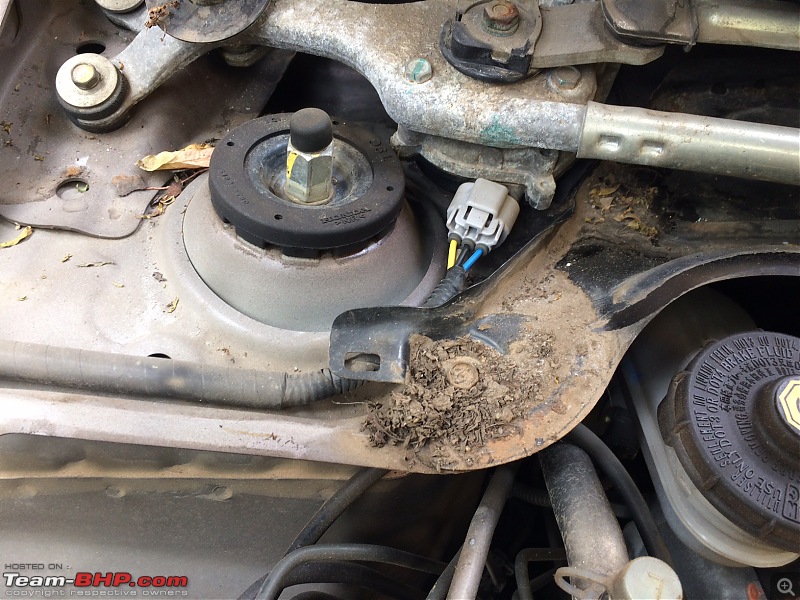
Finally decided to take matters into my own hands and clean the cowl panel at home.
The procedure to remove the plastic cladding is fairly simple. There are a total of 5 push pin type rivets and 2 nuts for the wipers to be removed. (In my enthusiasm to start, I forgot to take detailed pictures, but below should give you a fair idea).
The red boxes show the location of nuts and rivets. Remove the black caps at wiper ends to expose the nuts. The rivets pop out with a slight pressure from a flat head screwdriver.
Open plastic rivets here

Open wiper nuts here

The opened cladding and the grime


The cleaning itself can be done with water/car wash and a soft toothbrush for the hard to reach areas. I did not have any anti rust spray on hand, but will plan to have one for the next cleaning in ~3 months time.
The cleaned area

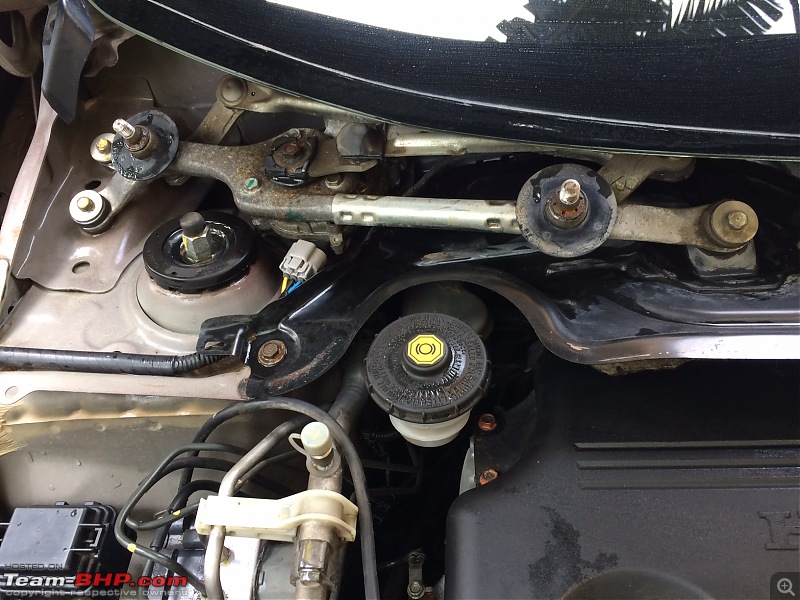
Saw the first rust spot on the panel. Remember this is a <3 years old car. Will need to treat this when I open the cladding next with emery paper and proper anti-rust paint.
Starting of rust
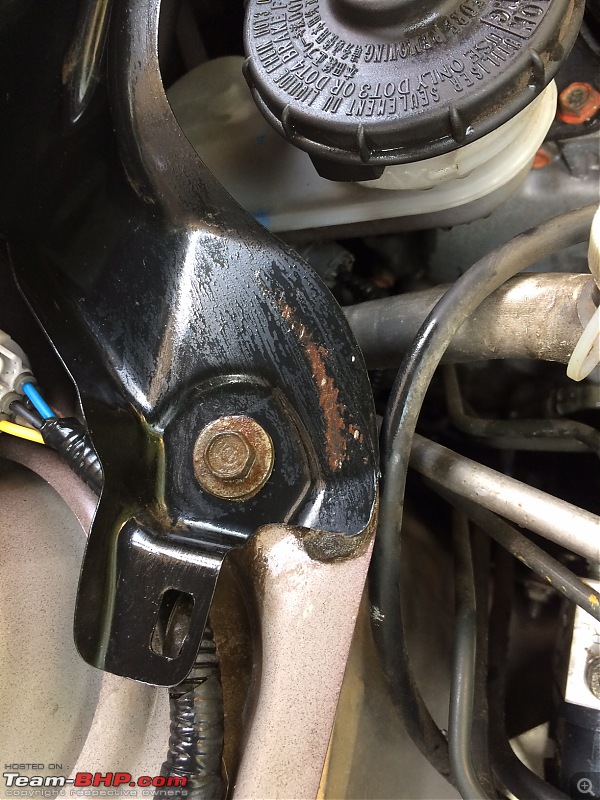
There are a couple of areas to be cleaned the next time as I did not have the right tools to carry out the job. For e.g. the area in the red box in the picture below is what rusted in the old car, while I cleaned it as far as possible, was fearful of damaging the windshield, need to figure out a way to clean it properly.
The edge of panel where windshield rests
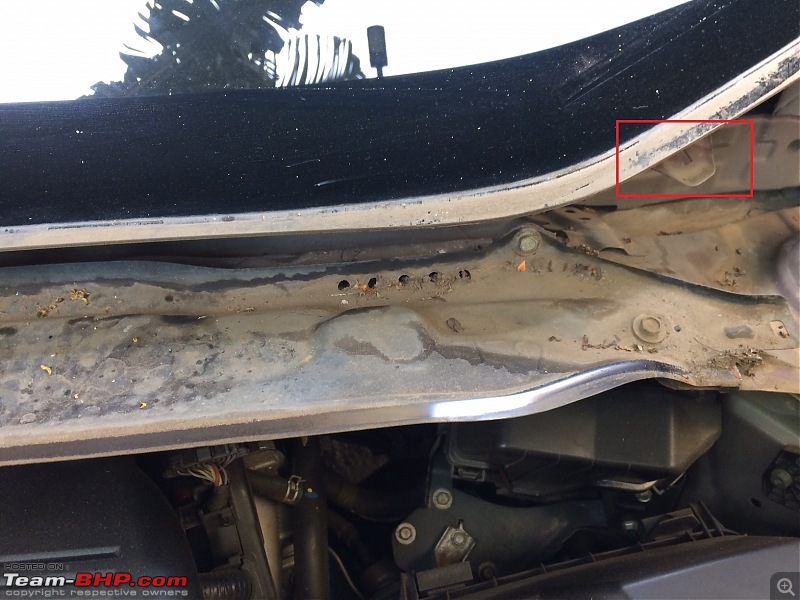
Service centers will go to any lengths to make a quick buck. Charging for cowl panel cleaning and AC service, things which you won't obviously see.
Come to think of it most lose their heads when the car comes back from the service center all shiny and polished.
Sometimes, that is all they do!!
As informed and aware people, we need to be aware of the work required and work done on our cars.
The DIY is fairly simple and took all of 45 min from start to finish. While this thread is focused on Honda City as that is the car I worked on, others should be largely similar.
Thread moved from the Assembly Line to the DIY Section. Thanks for sharing!
Quote:
Originally Posted by varunsangal
(Post 4373104)
I have owned a couple of Honda Cities (2004 and 2009) in the past and am on my third one (2015). One common trait to the first two was leakage of water in the cabin after the first few years. The cause for both was identified as rusted cowl panel.
|
Many thanks for this post. Specifically since you've owned a 2004 and a 2009, I request your inputs for my 2007 City ZX. I recently got the plastic cover removed and got pressure spray cleaning done in that area, but yes already a lot of rusting has taken hold.
a) You mentioned the rusted cowl panel was replaced, so did this involve removing and re-fitting the windshield ? Did it involve welding, or is it bolted body part that can be replaced without welding ?
b) Any tips you and other experts here can share, in terms of trying to limit / control the damage, in case repair / replacement gets complicated ?
Quote:
Originally Posted by //HB
(Post 4373842)
a) You mentioned the rusted cowl panel was replaced, so did this involve removing and re-fitting the windshield ? Did it involve welding, or is it bolted body part that can be replaced without welding
|
There are 2 parts:
The orange highlighted part is bolt-on (black highlight) and can be replaced easily. Does not require windshield replacement. Don't know if Honda sells this as a separate spare part.
This is from the 2009 City, as you can see this area was under the windshield and rusted badly. Repairing this requires a welding and painting job. Honda usually quotes ~35-40k INR for this. For my next cleaning, would ideally get a flat brush to remove all the dirt and put in an anti-rust spray. May not avoid rust altogether but at least prolong the life.
Quote:
Originally Posted by //HB
(Post 4373842)
b) Any tips you and other experts here can share, in terms of trying to limit / control the damage, in case repair / replacement gets complicated ?
|
I have been thinking on this, and will possibly look at removing the rubber beading around the front and rear glasses and get a thorough cleaning done. This is a hot spot for dirt and water and gets rusted really fast. However, needs an expert to remove and refit the beading. Wouldn't want to do it all alone, at least not the first time.
Great DIY!
I recently did the same on my sx4 which i was sure would have a lot of leaves and debris as it has never been cleaned or rather shall i say this is one of the most neglected areas leading to unwanted rust and expense.
In my case i used a spray and some amway car wash solution and scrubbed it with a tooth brush, then again spray with clean water, wipe and use air blower to dry.
Post this where ever i found rust spots i used a rust converter- 2 coats/then spray primer-2 coats and then final black paint spray-2 coats. This should be more then sufficient for the life of the car.
I used spray type cans which give great coverage in hard to reach places and proper finish too.
Yes the cowl is always a potential rust bucket in any car, due to its open yet hidden nature. Maruti 800 and Gypsy have the worst cowl design, as they are box sections without any significant accessible nature. That's the reason now plastic cowl tops are coming, which can be removed and cleaned easily. What's absurd is that Maruti 800s predecessor SS80 had a better cowl design!!
Quote:
Saw the first rust spot on the panel. Remember this is a <3 years old car. Will need to treat this when I open the cladding next with emery paper and proper anti-rust paint.
|
The rust is minor, you can also use a cloth wet with vinegar and put over the area. Vinegar eats all the rust and it comes like powder. Then you should put Zinc Primer, that's the best way IMO to protect any metal. :)
Do let me know if you need pics.
I'd also recommend coating the cleaned cowl with some strong coat, which will be more resistive to rust than simple paint, since this is one area which always gets wet and dirty. I have used Liqui Moly Bitumin coatings in cowls of both my cars, 800 and WagonR.
Regards,
Shashi
Quote:
Originally Posted by Leoshashi
(Post 4374114)
SS80 had a better cowl design!!
|
Completely agree. It was like an open box, just clean it daily/whenever you open the engine. But then those were the days.
Quote:
Originally Posted by Leoshashi
(Post 4374114)
...Zinc Primer, that's the best way IMO to protect any metal. Do let me know if you need pics.
I have used Liqui Moly Bitumin coatings in cowls of both my cars
|
It would be great if you can share pictures/details for both the zinc primer treatment and the Liqui Moly coating that you used.
I need to clean and put anti rust on the panel under the windscreen. That would rust the fastest.
Fantastic job done! And after having experienced this issue in your older cars as well, it is good that you are now preventing the issue than ending up with a greater bunch of repairs. However, this issue can happen in any car too. I clean the cowl of both cars once every few months. Especially after the rainy season since a lot of muck and leaves would have entered this area. I follow the same procedure, but use APC since that will be stronger than soap. Thankfully I have not found any rust in the cars till now.
Service centers are not interested to work on the finer aspects and attend to areas not visible to the eye. They will only make the engine bay look clean during every service and wont bother to check the cowl, clean the crevices etc.
Quote:
Originally Posted by audioholic
(Post 4374338)
Especially after the rainy season since a lot of muck and leaves would have entered this area.
|
It is amazing that an area which is constantly exposed to dirt and muck is hidden in modern cars, it should be open like in the old SS80 as Leoshashi pointed out. Just pour a bucket of water in every week and watch the dirt being washed away.
Quote:
Originally Posted by scorpian
(Post 4374341)
...try land rover lab...
|
Do you have an address or phone number I could reach out to them on? The Amazon ones seem a bit expensive.
Quote:
Originally Posted by scorpian
(Post 4374341)
|
Quote:
Originally Posted by Leoshashi
(Post 4374114)
The rust is minor, you can also use a cloth wet with vinegar and put over the area. Vinegar eats all the rust and it comes like powder. Then you should put Zinc Primer, that's the best way IMO to protect any metal. :)
I'd also recommend coating the cleaned cowl with some strong coat, which will be more resistive to rust than simple paint, since this is one area which always gets wet and dirty. I have used Liqui Moly Bitumin coatings in cowls of both my cars, 800 and WagonR.
Regards,
Shashi
|
I see a few different variants of "silencer spray coating" etc available online, would these be near about as effective as the Liqui Moly Zinc spray suggested ?
Quote:
Originally Posted by //HB
(Post 4374407)
I see a few different variants of "silencer spray coating" etc available online, would these be near about as effective as the Liqui Moly Zinc spray suggested ?
|
Will let Leoshashi comment on the finer points of effectiveness, but would think that any silencer spray would either be black and thick coating, or at least non-appealing visually, while the zinc spray should not spoil the visual appeal.
Quote:
Originally Posted by varunsangal
(Post 4373104)
The DIY is fairly simple and took all of 45 min from start to finish. While this thread is focused on Honda City as that is the car I worked on, others should be largely similar.
|
Thanks Varun.
Is this rust below the plastic cladding and if yes, how did water reach that spot
I see rubber seals in my DZire which is holding the plastic cladding little above the cowl.
Quote:
Originally Posted by prithm
(Post 4374448)
Is this rust below the plastic cladding and if yes, how did water reach that spot
I see rubber seals in my DZire which is holding the plastic cladding little above the cowl.
|
This rust is below the plastic cladding. All the water that rolls off the windscreen goes under the cladding and drains out through the drain holes on the side of the car.The black portion of the cowl panel protects the engine from the water flowing through there.
My 2008 Swift had its cowl panel changed as well last month.. The process is the same for Swift, remove wiper, remove plastic rivets, take out cladding and see the muck. Should not be vastly different for your DZire.
Quote:
Originally Posted by varunsangal
(Post 4374437)
Will let Leoshashi comment on the finer points of effectiveness, but would think that any silencer spray would either be black and thick coating, or at least non-appealing visually, while the zinc spray should not spoil the visual appeal.
|
Surface Rust removal: Soak the area in vinegar by using cloth or anything similar. Soak for an hour or two and the rust comes away like a powder if you touch it.
Checkout this flywheel, its an old stock, rusted. I just let it sit in a tub full of vinegar and then wiped away the rust. No sanding, no labour. Half the rust dissolves in the vintegar itself.
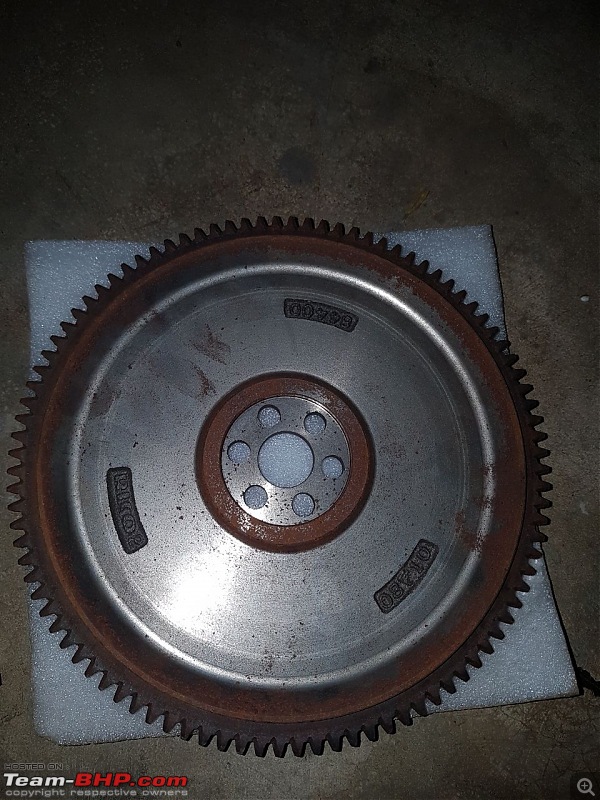



Primer: I use Liqui Moly ZInc primer. Available on Amazon, or I can give you the contact details of the distributor if you need it.
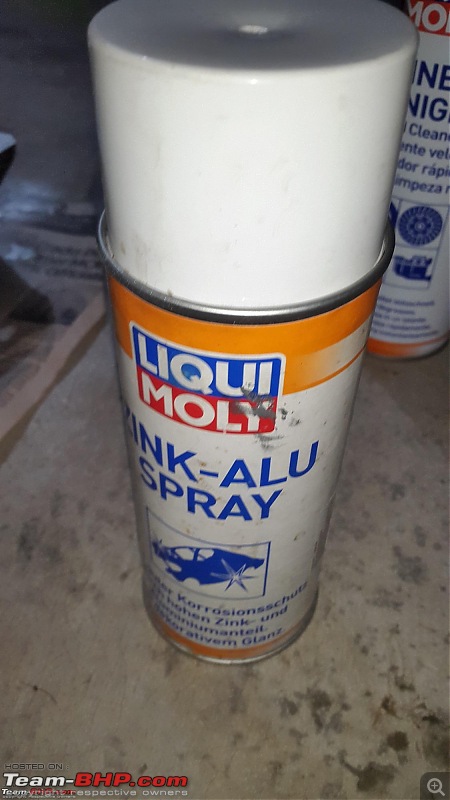
You may paint it after priming.
Last protection: Liqui Moly's Bitumin coating is super thick. But make sure the texture remains smooth else it will cause water accumulation.

That third from left is the Bitumin I was talking about. Some other rust prevention products I have:

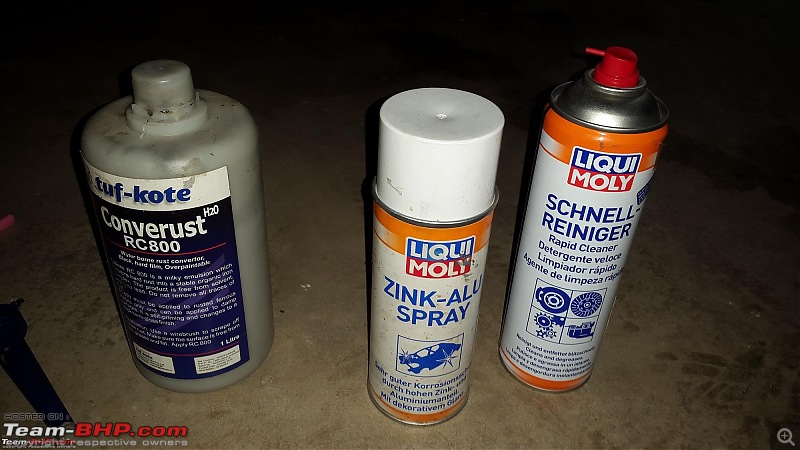
| All times are GMT +5.5. The time now is 05:57. | |









